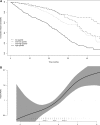Chronic kidney disease progression and outcome according to serum phosphorus in mild-to-moderate kidney dysfunction
- PMID: 21393493
- PMCID: PMC3069383
- DOI: 10.2215/CJN.07810910
Chronic kidney disease progression and outcome according to serum phosphorus in mild-to-moderate kidney dysfunction
Abstract
Background and objectives: Several factors might alter serum phosphate homeostasis and induce hyperhosphatemia in patients with chronic kidney disease (CKD) not requiring dialysis. However, whether and to what extent hyperphosphatemia is associated with a poor prognosis in different CKD patient groups remain to be elucidated.
Design, setting, participants & measurements: We utilized the "Prevenzione Insufficienza Renale Progressiva" (PIRP) database, a large project sponsored by the Emilia-Romagna Health Institute. PIRP is a collaborative network of nephrologists and general practitioners located in the Emilia-Romagna region, Italy, aimed at increasing awareness of CKD complications and optimizing CKD patient care. We identified 1716 patients who underwent a GFR and serum phosphorous assessment between 2004 and 2007. We tested whether phosphate levels ≥4.3 mg/dl are associated with the risk of CKD progression or all causes of death.
Results: Older age and male sex were associated with lower phosphate levels. Instead, higher phosphate levels were noted in patients with diabetes. Patients with phosphate levels ≥4.3 mg/dl were at an increased risk of starting dialysis or dying (hazard ratio 2.04; 95% confidence interval [1.44, 2.90]). Notably, subgroup analyses revealed that the magnitude of the risk associated with hyperphosphatemia varied depending on age, sex, diabetes, and different stages of CKD.
Conclusions: These analyses lend support to the hypothesis that phosphorous abnormalities might have a negative effect on the residual renal function and prognosis in different groups of CKD patients. However, the risk associated with hyperphosphatemia might vary in specific CKD patient subgroups.
© 2011 by the American Society of Nephrology
Figures




References
-
- Block GA, Hulbert-Shearon TE, Levin NW, Port FK: Association of serum phosphorus and calcium x phosphate product with mortality risk in chronic hemodialysis patients: A national study. Am J Kidney Dis 31: 607–617, 1998 - PubMed
-
- Block GA, Klassen PS, Lazarus JM, Ofsthun N, Lowrie EG, Chertow GM: Mineral metabolism, mortality, and morbidity in maintenance hemodialysis. J Am Soc Nephrol 15: 2208–2218, 2004 - PubMed
-
- Kalantar-Zadeh K, Kuwae N, Regidor DL, Kovesdy CP, Kilpatrick RD, Shinaberger CS, McAllister CJ, Budoff MJ, Salusky IB, Kopple JD: Survival predictability of time-varying indicators of bone disease in maintenance hemodialysis patients. Kidney Int 70: 771–780, 2006 - PubMed
-
- Kestenbaum B, Sampson JN, Rudser KD, Patterson DJ, Seliger SL, Young B, Sherrard DJ, Andress DL: Serum phosphate levels and mortality risk among people with chronic kidney disease. J Am Soc Nephrol 16: 520–528, 2005 - PubMed
-
- Dhingra R, Sullivan LM, Fox CS, Wang TJ, D'Agostino RB, Sr., Gaziano JM, Vasan RS: Relations of serum phosphorus and calcium levels to the incidence of cardiovascular disease in the community. Arch Intern Med 167: 879–885, 2007 - PubMed
MeSH terms
Substances
LinkOut - more resources
Full Text Sources
Other Literature Sources
Medical

